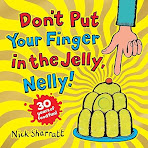Jello has been an American household staple since the 1800s. It is more than just a jiggling, sweet dessert. For many, it is also a craft ingredient, a party favorite, and, for many, a nostalgic trip down memory lane. What Americans call jello Australians call jelly.
Australians feel similarly about Aeroplane Jelly which first began in 1927 when Sydney tram driver Bert Appleroth had success selling jelly crystals which he first made in a bathtub. This small backyard operation evolved into one of Australia's largest family-operated food manufacturers before it was sold to McCormick Foods Australia in 1995.
Who thought there'd be a day when you had an excuse to make jelly, say all the fun jelly poems you know and read books about it while you eat it. Bliss and sugar overload!
If you're in the USA you could read Jello Man and learn about the its history.
Jello is a tasty treat that can be eaten any time of the year. Did you know that jello was first created around the latter 1800's by Pearle Wait. Its main ingredients are gelatin, sugar, and water which results in jello's wobbly texture. In this delicious story, a bowl of jello turns into a tasty treat!
If your elsewhere there are more books that feature jelly.
I love doing the rhyme Jelly on a Plate with my preschool classes. We are all so good at wobble wobbling. It is also the perfect verse to innovate on with other foods.
Jelly on a plate
Jelly on a plate
Wibble wobble
Wibble wobble
Jelly on a plate.
Look for other poems in Michael Rosen's Jelly Boots, Smelly Boots and Brian Patten's Gargling With Jelly.
Then these fun stories
I've often wondered whether the reason Americans don't have jelly like us is because they call jam, 'jelly'. When I was a child my mother made apple jelly and blackcurrant jelly and it was in a bottle like jam, but it was smooth and clear and didn't have any lumps of fruit in it like what we call jam.
It used to fascinate me when I heard of peanut butter and jelly sandwiches, because I thought that that meant they had jelly on sandwiches, until someone put me straight. Nadine Bernard Westcott's book Peanut Butter and Jelly then made more sense.












No comments:
Post a Comment